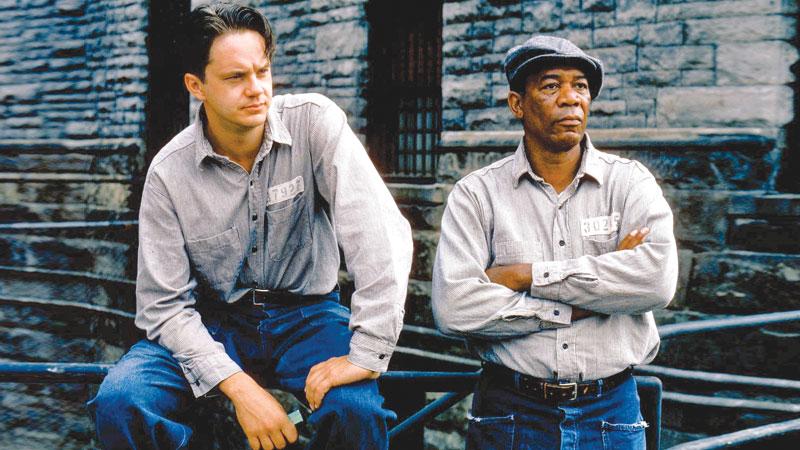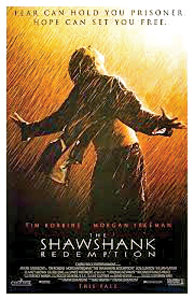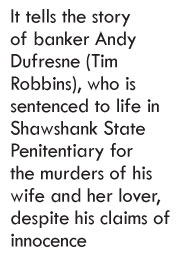
‘The Shawshank Redemption’ is a 1994 American drama film written and directed by Frank Darabont, based on the 1982 Stephen King novella ‘Rita Hayworth and Shawshank Redemption’.
It tells the story of banker Andy Dufresne (Tim Robbins), who is sentenced to life in Shawshank State Penitentiary for the murders of his wife and her lover, despite his claims of innocence. Over the following two decades, he befriends a fellow prisoner, contraband smuggler Ellis “Red” Redding (Morgan Freeman), and becomes instrumental in a money-laundering operation led by the prison warden Samuel Norton (Bob Gunton). William Sadler, Clancy Brown, Gil Bellows, and James Whitmore appear in supporting roles.
 Darabont purchased the film rights to King’s story in 1987, but development did not begin until five years later, when he wrote the script over an eight-week period. Two weeks after submitting his script to Castle Rock Entertainment, Darabont secured a $25 million budget to produce ‘The Shawshank Redemption’, which started pre-production in January 1993. While the film is set in Maine, principal photography took place from June to August 1993 almost entirely in Mansfield, Ohio, with the Ohio State Reformatory serving as the eponymous penitentiary. The project attracted many stars of the time for the role of Andy, including Tom Hanks, Tom Cruise, and Kevin Costner. Thomas Newman provided the film’s score.
Darabont purchased the film rights to King’s story in 1987, but development did not begin until five years later, when he wrote the script over an eight-week period. Two weeks after submitting his script to Castle Rock Entertainment, Darabont secured a $25 million budget to produce ‘The Shawshank Redemption’, which started pre-production in January 1993. While the film is set in Maine, principal photography took place from June to August 1993 almost entirely in Mansfield, Ohio, with the Ohio State Reformatory serving as the eponymous penitentiary. The project attracted many stars of the time for the role of Andy, including Tom Hanks, Tom Cruise, and Kevin Costner. Thomas Newman provided the film’s score.
While ‘The Shawshank Redemption’ received critical acclaim on its release, particularly for its story and the performances of Robbins and Freeman, it was a box-office disappointment, earning only $16 million during its initial theatrical run. Many reasons were cited for its failure at the time, including competition from films such as ‘Pulp Fiction’ and ‘Forrest Gump’, the general unpopularity of prison films, its lack of female characters, and even the title, which was considered to be confusing for audiences. It went on to receive multiple award nominations, including seven Academy Award nominations, and a theatrical re-release that, combined with international takings, increased the film’s box-office gross to $58.3 million.
Over 320,000 VHS rental copies were shipped throughout the United States, and on the strength of its award nominations and word of mouth, it became one of the top video rentals of 1995.
The broadcast rights were acquired following the purchase of Castle Rock by Turner Broadcasting System, and it was shown regularly on the TNT network starting in 1997, further increasing its popularity. Decades after its release, the film was still broadcast regularly, and is popular in several countries, with audience members and celebrities citing it as a source of inspiration, and naming the film as a favorite in various surveys. In 2015, the United States Library of Congress selected the film for preservation in the National Film Registry, finding it “culturally, historically, or aesthetically significant”.
Analysis
The film has been interpreted as being grounded in Christian mysticism. Andy is offered as a messianic, Christ-like figure, with Red describing him early in the film as having an aura that engulfs and protects him from Shawshank.
The scene in which Andy and several inmates tar the prison roof can be seen as a recreation of the Last Supper, with Andy obtaining beer/wine for the twelve inmates/disciples as Freeman describes them as the “lords of all creation” invoking Jesus’ blessing. Director Frank Darabont responded that this was not his deliberate intention, but he wanted people to find their own meaning in the film. The discovery of ‘The Marriage of Figaro’ record is described in the screenplay as akin to finding the Holy Grail, bringing the prisoners to a halt, and causing the sick to rise up in their beds.
Early in the film, Warden Norton quotes Jesus Christ to describe himself to Andy, saying, “I am the light of the world”, declaring himself Andy’s savior, but this description can also reference Lucifer, the bearer of light. Indeed, the warden does not enforce the general rule of law, but chooses to enforce his own rules and punishments as he sees fit, becoming a law unto himself, like the behavior of Satan.
Holy man
The warden has also been compared to former United States President Richard Nixon. Norton’s appearance and public addresses can be seen to mirror Nixon’s. Similarly, Norton projects an image of a holy man, speaking down sanctimoniously to the servile masses while running corrupt scams, like those of which Nixon was accused.
 Zihuatanejo has been interpreted as an analogue for heaven or paradise. In the film, Andy describes it as a place with no memory, offering absolution from his sins by forgetting about them or allowing them to be washed away by the Pacific Ocean, whose name means “peace”.
Zihuatanejo has been interpreted as an analogue for heaven or paradise. In the film, Andy describes it as a place with no memory, offering absolution from his sins by forgetting about them or allowing them to be washed away by the Pacific Ocean, whose name means “peace”.
The possibility of escaping to Zihuatanejo is only raised after Andy admits that he feels responsible for his wife’s death. Similarly, Red’s freedom is only earned once he accepts he cannot save himself or atone for his sins. Freeman has described Red’s story as one of salvation as he is not innocent of his crimes, unlike Andy who finds redemption.
While some Christian viewers interpret Zihuatanejo as heaven, it can also be interpreted as a Nietzschean form of guiltlessness achieved outside traditional notions of good and evil, where the amnesia offered is the destruction rather than forgiveness of sin, meaning Andy’s aim is secular and atheistic. Just as Andy can be interpreted as a Christ-like figure, he can be seen as a Zarathustra-like prophet offering escape through education and the experience of freedom. Film critic Roger Ebert argued that ‘The Shawshank Redemption’ is an allegory for maintaining one’s feeling of self-worth when placed in a hopeless position. Andy’s integrity is an important theme in the story line, especially in prison, where integrity is lacking.
Robbins himself believes that the concept of Zihuatanejo resonates with audiences because it represents a form of escape that can be achieved after surviving for many years within whatever “jail” someone finds themselves in, whether a bad relationship, job, or environment.
Robbins said that it is important that such a place exists for us. Isaac M. Morehouse suggests that the film provides a great illustration of how characters can be free, even in prison, or imprisoned, even in freedom, based on their outlooks on life.
Freedom
Philosopher Jean-Paul Sartre described freedom as an ongoing project that requires attention and resilience, without which a person begins to be defined by others or institutions, mirroring Red’s belief that inmates become dependent on the prison to define their lives. Andy displays resilience through rebellion, by playing music over the prison loudspeaker, and refusing to continue with the money-laundering scam.
Many elements can be considered as tributes to the power of cinema. In the prison theater, the inmates watch the film ‘Gilda’ (1946), but this scene was originally intended to feature The Lost Weekend (1945). The interchangeability of the films used in the prison theater suggests that it is the cinematic experience and not the subject that is key to the scene, allowing the men to escape the reality of their situation. Immediately following this scene, Andy is assaulted by the Sisters in the projector room and uses a film reel to help fight them off. Then in the end of the film, Andy passes through a hole in his cell hidden by a movie poster to escape both his cell and ultimately Shawshank.
Andy and Red’s relationship has been described as a nonsexual story between two men that few other films offer, where the friendship is not built on conducting a caper, car chases, or developing a relationship with women. Philosopher Alexander Hooke argued that Andy and Red’s true freedom is their friendship, being able to share joy and humor with each other.
